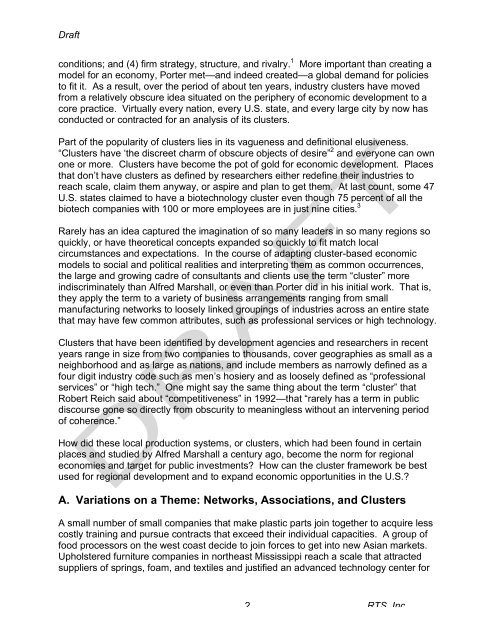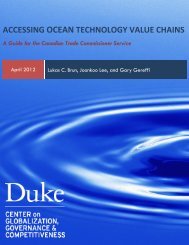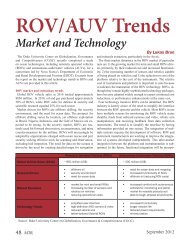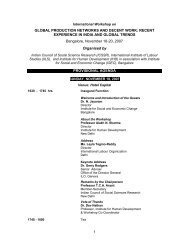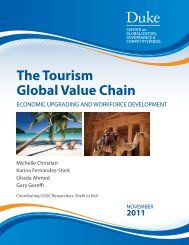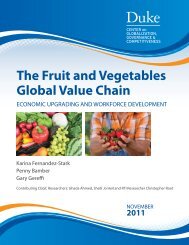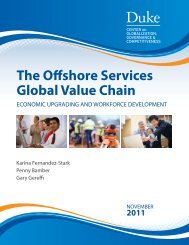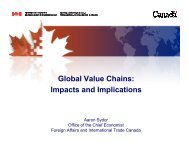Paper - Center on Globalization, Governance & Competitiveness
Paper - Center on Globalization, Governance & Competitiveness
Paper - Center on Globalization, Governance & Competitiveness
Create successful ePaper yourself
Turn your PDF publications into a flip-book with our unique Google optimized e-Paper software.
Draft<br />
c<strong>on</strong>diti<strong>on</strong>s; and (4) firm strategy, structure, and rivalry. 1 More important than creating a<br />
model for an ec<strong>on</strong>omy, Porter met—and indeed created—a global demand for policies<br />
to fit it. As a result, over the period of about ten years, industry clusters have moved<br />
from a relatively obscure idea situated <strong>on</strong> the periphery of ec<strong>on</strong>omic development to a<br />
core practice. Virtually every nati<strong>on</strong>, every U.S. state, and every large city by now has<br />
c<strong>on</strong>ducted or c<strong>on</strong>tracted for an analysis of its clusters.<br />
Part of the popularity of clusters lies in its vagueness and definiti<strong>on</strong>al elusiveness.<br />
“Clusters have ‘the discreet charm of obscure objects of desire” 2 and every<strong>on</strong>e can own<br />
<strong>on</strong>e or more. Clusters have become the pot of gold for ec<strong>on</strong>omic development. Places<br />
that d<strong>on</strong>’t have clusters as defined by researchers either redefine their industries to<br />
reach scale, claim them anyway, or aspire and plan to get them. At last count, some 47<br />
U.S. states claimed to have a biotechnology cluster even though 75 percent of all the<br />
biotech companies with 100 or more employees are in just nine cities. 3<br />
Rarely has an idea captured the imaginati<strong>on</strong> of so many leaders in so many regi<strong>on</strong>s so<br />
quickly, or have theoretical c<strong>on</strong>cepts expanded so quickly to fit match local<br />
circumstances and expectati<strong>on</strong>s. In the course of adapting cluster-based ec<strong>on</strong>omic<br />
models to social and political realities and interpreting them as comm<strong>on</strong> occurrences,<br />
the large and growing cadre of c<strong>on</strong>sultants and clients use the term “cluster” more<br />
indiscriminately than Alfred Marshall, or even than Porter did in his initial work. That is,<br />
they apply the term to a variety of business arrangements ranging from small<br />
manufacturing networks to loosely linked groupings of industries across an entire state<br />
that may have few comm<strong>on</strong> attributes, such as professi<strong>on</strong>al services or high technology.<br />
Clusters that have been identified by development agencies and researchers in recent<br />
years range in size from two companies to thousands, cover geographies as small as a<br />
neighborhood and as large as nati<strong>on</strong>s, and include members as narrowly defined as a<br />
four digit industry code such as men’s hosiery and as loosely defined as “professi<strong>on</strong>al<br />
services” or “high tech.” One might say the same thing about the term “cluster” that<br />
Robert Reich said about “competitiveness” in 1992—that “rarely has a term in public<br />
discourse g<strong>on</strong>e so directly from obscurity to meaningless without an intervening period<br />
of coherence.”<br />
How did these local producti<strong>on</strong> systems, or clusters, which had been found in certain<br />
places and studied by Alfred Marshall a century ago, become the norm for regi<strong>on</strong>al<br />
ec<strong>on</strong>omies and target for public investments? How can the cluster framework be best<br />
used for regi<strong>on</strong>al development and to expand ec<strong>on</strong>omic opportunities in the U.S.?<br />
A. Variati<strong>on</strong>s <strong>on</strong> a Theme: Networks, Associati<strong>on</strong>s, and Clusters<br />
A small number of small companies that make plastic parts join together to acquire less<br />
costly training and pursue c<strong>on</strong>tracts that exceed their individual capacities. A group of<br />
food processors <strong>on</strong> the west coast decide to join forces to get into new Asian markets.<br />
Upholstered furniture companies in northeast Mississippi reach a scale that attracted<br />
suppliers of springs, foam, and textiles and justified an advanced technology center for<br />
2<br />
RTS, Inc.


